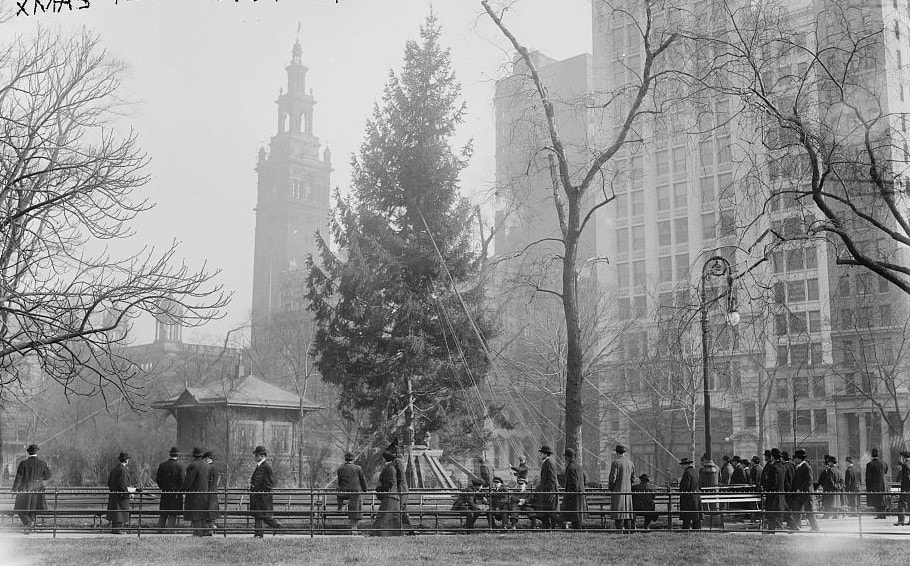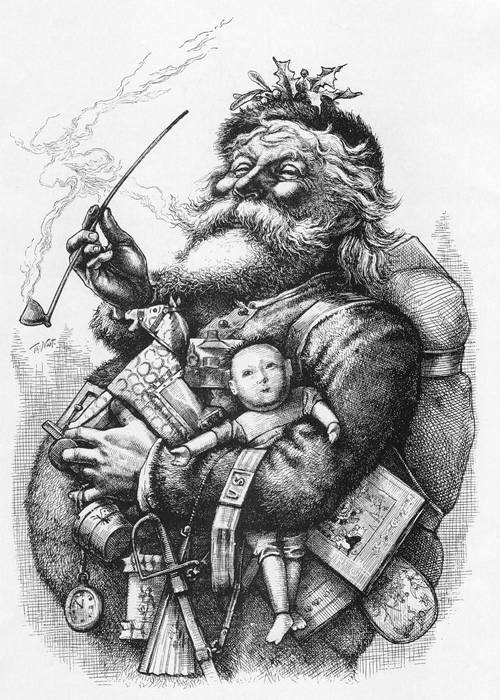|
By Laurie Lewis After the Revolutionary War, Americans shunned English traditions, including Christmas festivities. It wasn’t until the early nineteenth century when Washington Irving, a New Yorker, wrote popular stories about warm-hearted English Christmases that Americans began to long for the holiday. Irving also wrote about St. Nicholas and the presents he brought to children, leading Americans to turn Christmas into a child-centered, family affair. Some maintain that Washington Irving almost single-handedly created the American Christmas. A fellow New Yorker from the same period, Clement Clarke Moore, wrote a poem for his children that gave form to St. Nick. The first printing of Moore’s poem “A Visit from St. Nicholas” (a.k.a. “’Twas the night before Christmas”) was in 1823; it was published anonymously. Forty years later, New York cartoonist Thomas Nast started drawing pictures of Santa Claus—St. Nick by another name—for Harper’s Weekly. Now nobody would have trouble picturing the jolly fat man. "Merry Old Santa Claus" by Thomas Nast. Harper's Weekly, January 1, 1881. Nast's first depiction of Santa in Harper's was in 1863. Macy’s claims to have had the first department store Santa, introduced in 1862. Previously, in 1841, Philadelphia delicatessen owner J. W. Parkinson enticed children to his shop (not a department store) with a man dressed like Santa. James Edgar of Brockton, Massachusetts, maintained that the Santa in his department store in 1890 was the first, because Macy’s character didn’t look like the Thomas Nast figure. The first department store Santa may be disputed, but the first store with a Black Santa Claus is certain. It was Blumstein’s department store in Harlem, and the year was 1943. Only nine years earlier, Blumstein’s had been the target of a boycott for refusing to hire African American sales staff, even though most of its customers were Black. A decorated, lit tree is as symbolic of Christmas as is Santa. Initially, the illumination came from candles. In 1882, Edward H. Johnson, a colleague of Thomas Edison, decided to use this new-fangled thing called electricity to illuminate the Christmas tree in his Manhattan home. He strung together eighty small, colorful light bulbs and placed them around the tree. As if that wasn’t enough, he rotated the tree using electricity, wowing everyone who came by to see the first electric Christmas tree lights. The use of electric lights on Christmas trees was slow to catch on, however, because they were expensive and had to be put together by a knowledgeable electrician, such as the inventor Johnson. The first electrically lit Christmas tree, in the home of Edward Johnson. He placed it near a window so people on the street could see it. A Christmas tree for the home was a luxury that many of New York’s poorest in the early twentieth century could ill afford. In 1912, a seventy-foot pine cut down in the Adirondack Mountains was put up in Madison Square Park and decorated with lights. This was the first outdoor community Christmas tree in the United States. Thousands of New Yorkers gathered around the tree and enjoyed holiday music. The Star of Hope, a five-pointed star on a pole half as tall as the original tree, marks the site today.  The first outdoor community Christmas tree, in Madison Square Park. Did I mention holiday music? Several of the best-selling songs of the Yule season are creations of New Yorkers. The top of the charts—not just for seasonal songs but for the best-selling single of all time among all genres—is “White Christmas,” written by Irving Berlin and recorded in 1941 by Bing Crosby. In 2019, Mariah Carey’s “All I Want for Christmas Is You” became the biggest hit. Both Berlin and Carey lived in New York City. Being Jewish, Berlin did not celebrate Christmas. In fact, it was a sad day for him, because his infant son had died years earlier on December 25.  *Adapted from New York City Firsts: Big Apple Innovations That Changed the Nation and the World by Laurie Lewis. Publication, by Globe Pequot, is scheduled for April 2022. The book can be preordered now from Amazon and Barnes & Noble. Tours
Scheduled tours are suspended during the coronavirus pandemic. If you would like ideas for private or custom tours, please see our website www.takeawalknewyork.com. Comments are closed.
|
Archives
April 2024
|




